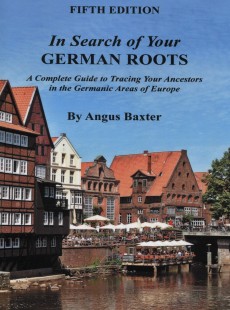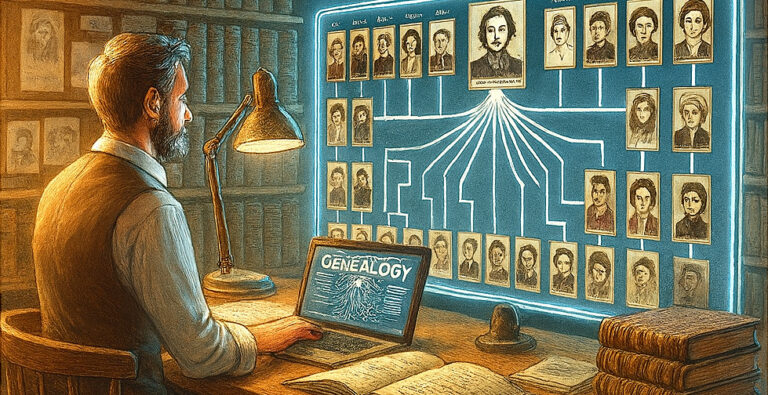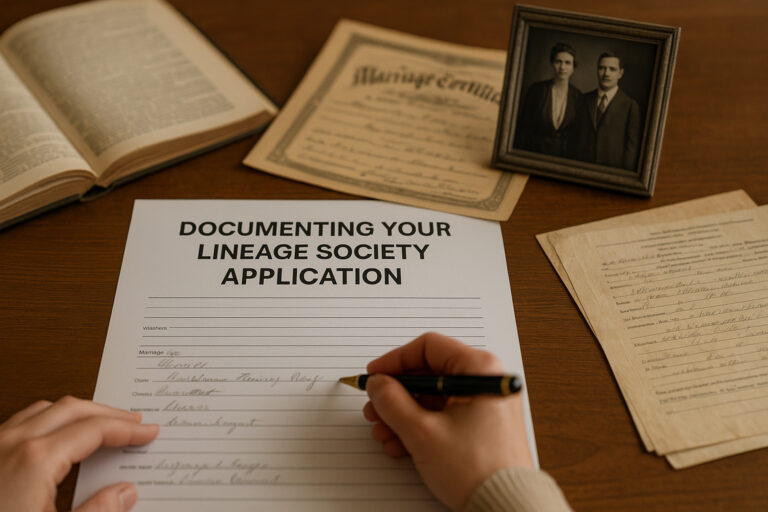
“The Germans and Germany,” by Angus Baxter (Part Two)
[The second part of this article is condensed from the chapter by the same name in the 5th Edition of Mr. Baxter’s classic how-to book, In Search of Your German Roots. Readers should note that, in the interest of brevity, a number of tables in the book which describe the migration and distribution of the German population and the contemporary archival holdings of other nations that have a bearing on German genealogy have been omitted from this except. Part one of the article, which appeared in the March 29 issue of “Genealogy Pointers,” summarized Germanic migration and settlement patterns prior to the unification of the country in 1871. Part Two picks up the story from that point. ]
The Process of German Unification
Germany only existed as an undivided country from 1871 until 1945–in contrast with England and France, which had been unified for more than five centuries. Systems of government in the various German states ranged from absolute monarchies to the near-democracy of some of the electorates and free cities. Various forms of confederation or economic grouping took hold, flowered for a few years, and died. Each state had its own laws, archives, and system of recording events. You cannot say, for example, that “censuses were first held in Germany in 1871.” That is true for the unified Germany, but censuses were taken in Wurttemberg in 1821, in Baden in 1852, and so on. The only unified force in the Germanic area was the church–first the Catholic and later the Lutheran.
By the middle of the 19th century the number of self-governing German states had been reduced to 34. Some of these formed the German Confederation, which also included Austria–still trying to assert its position as leader of the German people. However, the alliance was a shaky one because of the emerging power of Prussia, under the leadership of the great Bismarck. The two rivals did join together in an attack on Denmark in 1866 and seized Schleswig-Holstein, which they divided between them. A few months later they quarreled over the “spoils” and Prussia took over the whole territory. At this point Austria withdrew from the German Confederation and joined with Hungary in 1867 to form the Austro-Hungarian Empire.
The German Confederation was then renamed the North German Confederation under the leadership of Prussia, and it included all the states north of the River Main. The eastern boundary was extended as far as Memel. In 1871, following a short and successful war against France, Prussia persuaded the southern states to join the Confederation with its new name of German Empire (Deutsches Reich). The king of Prussia was then proclaimed emperor on January 16, 1871. Suddenly, in the very center of Europe, a most powerful new country existed, and for the first time in over a thousand years the German people were one nation under strong leadership.
In the short period of a quarter of a century the German people had developed a pride in their nation, which was strong enough to overcome the hatreds and mistrusts of a thousand years of division and despair.
The new empire included the following territory:
(a) Kingdoms of Bavaria, Prussia, Saxony, and Wurttemberg
(b) Grand Duchy of Baden
(c) Free Cities of Bremen, Hamburg, and Lubeck, and Anhalt, Brunswick, Darmstadt, Hesse, Lippe, Mecklenburg, Oldenburg, Reuss, and the various states comprising Thuringia. (Justice, education, health, and police were left under the control of the individual states.)
During the period of unification between 1871 and 1945, little or no attempt was made to centralize records in one place such as the capital, Berlin. Instead, records remained in the capital cities of the original states. In retrospect, this was a blessing to ancestor-hunters because the destruction of German records during the Second World War was surprisingly small. Imagine what would have happened if everything had been in Berlin!
Details have already been given of the post-war dismemberment of Germany and the transfer of territory to Czechoslovakia, Poland, and the USSR. The remaining part of Germany was then divided into the eastern half, occupied by the USSR, and the western half, occupied by Britain, Belgium, France, and the United States. These two parts later became the German Democratic Republic (Deutsche Demokratische Republik, or D.D.R.) and the Federal Republic of Germany (Bundesrepublik Deutschland, or B.R.D.). Details of the division were as follows:
D.D.R.: Anhalt, Brandenburg (western part), part of Brunswick (Braunschweig), Mecklenburg-Schwerin, Mecklenburg-Strelitz, Reuss, Sachsen-Altenburg, Sachsen-Meiningen, Sachsen-Weimar, Schwarzburg-Rudolstadt, and Schwarzburg-Sondershausen. Also four provinces of the State of Prussia (the parts remaining after territory taken by the three countries mentioned above).
B.R.D.: Baden, Bavaria (Bayern), part of Brunswick (Braunschweig), Coburg, Lippe, Oldenburg, Schaumberg-Lippe, part of Thuringia (Thuringen), Waldeck, Westphalia (Westfalen), and Wurttemberg; and five provinces of the State of Prussia–Hanover (Hannover), Hessen-Nassau, Rhineland (Rheinland), Schleswig-Holstein, and Sigmaringen.
After the division of Germany in 1945 various changes were made in each section of the country, and they were administered as follows:
D.D.R.: Originally this consisted of five provinces (Lander). These were abolished and replaced by 15 districts (Kreise). However, the D.D.R., unlike the B.R.D., was not a federal state, and all power was centered in the capital (East, or Ost, Berlin).
B.R.D.: Originally this consisted of ten federal states (Bundeslander, or just Lander): Baden-Wurttemberg, Bavaria (Bayern), Bremen (city-state), Hamburg (city-state), Hesse (Hessen), Lower Saxony (Niedersachsen), North Rhine-Westphalia (Nordrhein-Westfalen), Rhineland-Palatinate (Rheinland-Pfalz), Saarland, and Schleswig-Holstein. The city-state of Berlin (West) was integrated into the legal and economic system of the Federal Republic. The republic was further divided into 25 administrative areas (Regierungsbezirke), 327 counties or districts (Kreise), and about 8,500 municipalities.
[Today] the 16 states of the unified country and their capital cities are:
- Baden-Wurttemberg (Stuttgart)
- Bayern (Munich/Munchen)
- Berlin
- Brandenburg (Potsdam)*
- Bremen
- Hamburg
- Hessen (Wiesbaden)
- Mecklenburg-Vorpommern (Schwerin)*
- Niedersachsen (Hannover)
- Nordrhein-Westfalen (Dusseldorf)
- Rheinland-Pfalz (Mainz)
- Saarland (Saarbrucken)
- Sachsen (Dresden)*
- Sachsen-Anhalt (Magdeburg)*
- Schleswig-Holstein (Kiel)
- Thuringen (Erfurt)*
*The Lander marked with an asterisk (*) are the political divisions of the area previously known as East Germany. They replace the 15 districts (Bezirkes) mentioned [above]. The names of the districts within each of the five Lander are:
- Brandenburg: Berlin, Cottbus, Frankfurt, Potsdam
- Mecklenburg-Vorpommern: Neubrandenburg, Rostock, Schwerin
- Sachsen: Dresden, Chemnitz (formerly Karl-Marx-Stadt), Leipzig
- Sachsen-Anhalt: Halle, Magdeburg
- Thuringen: Erfurt, Gera, Suhl
- The Continuing Migration
After the Second World War, approximately 13 million Germans left their homes in other European countries and found refuge in the Fatherland. Since the unification of Germany and free emigration from the former Soviet Union and Eastern Europe, there has been a huge influx of ethnic Germans. Nearly 400,000 came in 1989, followed by more than 200,000 annually between 1991 and 1995.
The Germans in Kazakhstan may number as many as a million–some descended from the Germans who originally settled in the Volga Basin at the invitation of Catherine the Great, and others who were exiled from Ukraine by Stalin.
If you know you have German relatives in the former Soviet Union, Poland, or Romania you may be able to make contact through the International Red Cross or the Federal Ministry of the Interior in Bonn. [END OF ARTICLE] Read Part One
For more information about the 5th Edition of Angus Baxter’s classic how-to book, In Search of Your German Roots, please click the following button.
You may also wish to browse our considerable list of German genealogy source books and family history anthologies here: Store – Genealogical.com




